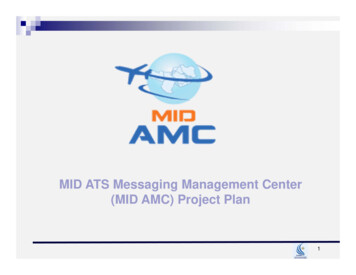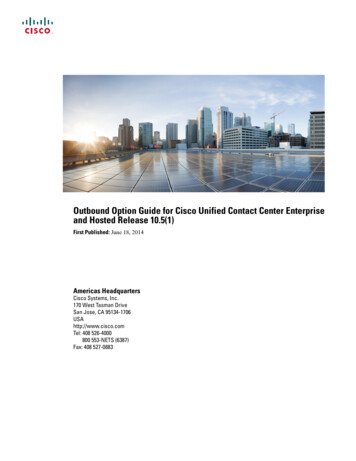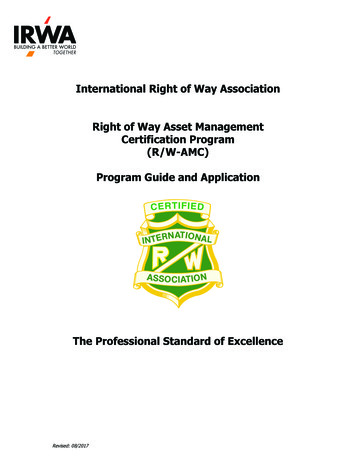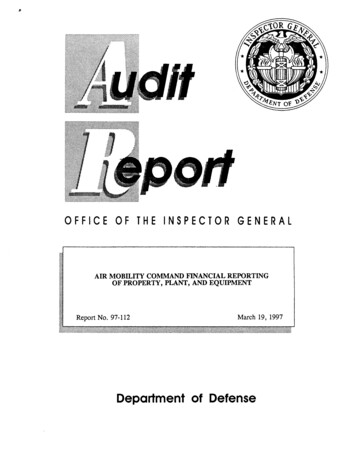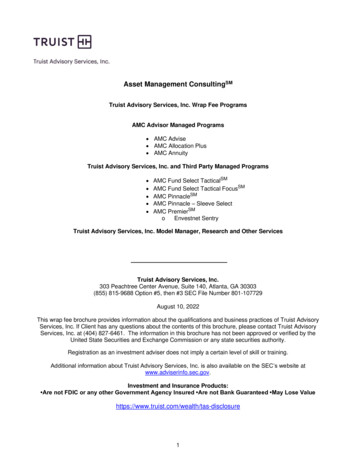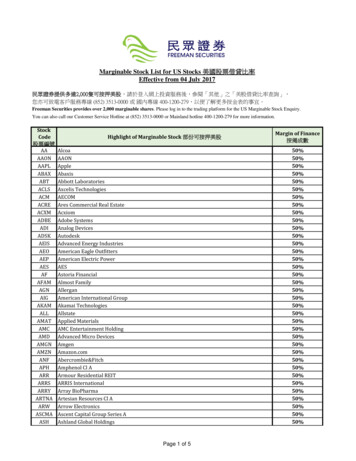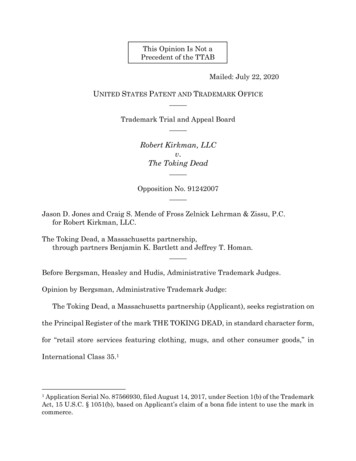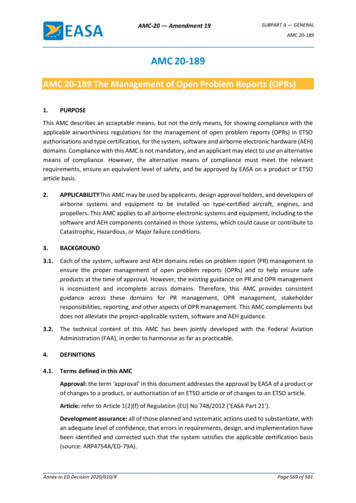
Transcription
AMC-20 — Amendment 19SUBPART A — GENERALAMC 20-189AMC 20-189AMC 20-189 The Management of Open Problem Reports (OPRs)1.PURPOSEThis AMC describes an acceptable means, but not the only means, for showing compliance with theapplicable airworthiness regulations for the management of open problem reports (OPRs) in ETSOauthorisations and type certification, for the system, software and airborne electronic hardware (AEH)domains. Compliance with this AMC is not mandatory, and an applicant may elect to use an alternativemeans of compliance. However, the alternative means of compliance must meet the relevantrequirements, ensure an equivalent level of safety, and be approved by EASA on a product or ETSOarticle basis.2.APPLICABILITYThis AMC may be used by applicants, design approval holders, and developers ofairborne systems and equipment to be installed on type-certified aircraft, engines, andpropellers. This AMC applies to all airborne electronic systems and equipment, including to thesoftware and AEH components contained in those systems, which could cause or contribute toCatastrophic, Hazardous, or Major failure conditions.3.BACKGROUND3.1.Each of the system, software and AEH domains relies on problem report (PR) management toensure the proper management of open problem reports (OPRs) and to help ensure safeproducts at the time of approval. However, the existing guidance on PR and OPR managementis inconsistent and incomplete across domains. Therefore, this AMC provides consistentguidance across these domains for PR management, OPR management, stakeholderresponsibilities, reporting, and other aspects of OPR management. This AMC complements butdoes not alleviate the project-applicable system, software and AEH guidance.3.2.The technical content of this AMC has been jointly developed with the Federal AviationAdministration (FAA), in order to harmonise as far as practicable.4.DEFINITIONS4.1.Terms defined in this AMCApproval: the term ‘approval’ in this document addresses the approval by EASA of a product orof changes to a product, or authorisation of an ETSO article or of changes to an ETSO article.Article: refer to Article 1(2)(f) of Regulation (EU) No 748/2012 (‘EASA Part 21’).Development assurance: all of those planned and systematic actions used to substantiate, withan adequate level of confidence, that errors in requirements, design, and implementation havebeen identified and corrected such that the system satisfies the applicable certification basis(source: ARP4754A/ED-79A).Annex to ED Decision 2020/010/RPage 569 of 581
AMC-20 — Amendment 19SUBPART A — GENERALAMC 20-189Equipment: an item or collection of items with a defined set of requirements.Error: a mistake in the requirements, design, or implementation with the potential of producinga failure.Failure: the inability of a system or system component to perform a function within specifiedlimits (source: DO-178C/ED-12C and DO-254/ED-80).Item: a hardware or software element that has bounded and well-defined interfaces (source:ARP4754A/ED-79A).Open problem report (OPR): a problem report that has not reached the state ‘Closed’ at thetime of approval.Problem report (PR): a means to identify and record the resolution of anomalous behaviour,process non-compliance with development assurance plans and standards, and deficiencies inlife-cycle data (adapted from DO-178C/ED-12C).Product: refer to Article 3(3) of Regulation (EU) 2018/1139 (the ‘EASA Basic Regulation’).System: a combination of interrelated equipment, article(s), and/or items arranged to performa specific function (or functions) within a product.4.2.States of PRs/OPRsRecorded: a problem that has been documented using the problem-reporting process.Classified: a problem report that has been categorised in accordance with an establishedclassification scheme.Resolved: a problem report that has been corrected or fully mitigated, for which the resolutionof the problem has been verified but not formally reviewed and confirmed.Closed: a resolved problem report that underwent a formal review and confirmation of theeffective resolution of the problem.4.3.Classifications of PRs/OPRs‘Significant’: assessed at the product, system, or equipment level, a PR that has an actual orpotential effect on the product, system, or equipment function that may lead to a Catastrophic,Hazardous or Major failure condition, or may affect compliance with the operating rules.‘Functional’: a PR that has an actual or a potential effect on a function at the product, system,or equipment level.‘Process’: a PR that records a process non-compliance or deficiency that cannot result in apotential safety, nor a potential functional, effect.‘Life-cycle data’: a PR that is linked to a deficiency in a life-cycle data item but not linked to aprocess non-compliance or process deficiency.5.PROBLEM REPORT MANAGEMENTAnnex to ED Decision 2020/010/RPage 570 of 581
AMC-20 — Amendment 19SUBPART A — GENERALAMC 20-189The PR management process is a key enabler for the management of OPRs. The PR managementprocess enables the consistent and timely management of problems encountered across the system,software and AEH domains. Consequently, this process reduces the risk of a loss of visibility of criticalissues remaining at the time of approval.5.1A PR management process across the system, software and AEH domains should be establishedand used during the development (both for initial certification and subsequent changes) of aproduct or an ETSO article. The PR management process should address the review andresolution of PRs that impact the transition to other development assurance processes.5.2A problem recorded after approval should also be managed through the PR managementprocess, and any related systemic process issues should be identified and corrected.5.3PRs that cannot be resolved by the current stakeholder should be reported in a manner that isunderstandable to the affected stakeholders.5.4For PRs that may have an impact on other products or articles that are developed within anorganisation, a means should be established for sharing PR information so that any necessarycorrective actions can be taken.6.OPR MANAGEMENTAn OPR management process, based on the PR management process, should be established acrossthe system, software and AEH domains, including the following process steps:6.1The classification of OPRs6.1.1 The applicant should establish an OPR classification scheme including, at a minimum, thefollowing classifications: ‘Significant’, ‘Functional’, ‘Process’ and ‘Life-cycle data’. Otherclassifications or subclassifications may be created as needed. The classification scheme shouldbe described in the appropriate planning document(s).6.1.2 Each OPR should be assigned a single classification per the classification scheme. When multipleclassifications apply, the OPR should be assigned the classification with the highest priority. Thepriority from highest to lowest (including the defined subclassifications) cess’;4.‘Life-cycle data’;5.any other OPR classification.Note: The classification of an individual OPR may differ from one stakeholder to another,depending on the known mitigations at the time of classification.6.1.3 The classification of an OPR should account for and document all the mitigations known at thetime of classification that are under the control of the classifying stakeholder. A mitigation thatis controlled by another stakeholder may be considered in the classification only if validatedwith that stakeholder, and provided this mitigation remains acceptable in the frame of the typeAnnex to ED Decision 2020/010/RPage 571 of 581
AMC-20 — Amendment 19SUBPART A — GENERALAMC 20-189certificate (TC) / supplemental type certificate (STC) approval or European technical standardorder (ETSO) article authorisation, as applicable.6.1.4 A stakeholder, other than the aircraft TC or STC applicant, should classify as ‘Significant’ anyOPR for which the classification may vary between ‘Functional’ and ‘Significant’, depending onthe installation.6.2The assessment of OPRsEach OPR should be assessed to determine:1.any resulting functional limitations or operational restrictions at the equipment level (forETSOs) or at the product level (for other types of approvals);2.relationships that may exist with other OPRs; and3.for a ‘Significant’ or ‘Functional’ OPR, the underlying technical cause of the problem.6.3Disposition: OPRs classified as ‘Significant’ per the classification in Section 6.1, for which nosufficient mitigation or justification exists to substantiate the acceptability of the safety effect,should be resolved prior to approval. The disposition of OPRs may involve coordination with thecertification authority.6.4Reporting: an OPR summary report should be prepared and provided to the affectedstakeholder(s), and to the certification authority upon request. The OPR summary report maybe an aggregation of summaries (e.g. Software/Hardware Accomplishment Summaries orsystem-level OPR reports) prepared by all the involved stakeholders. The summary reportshould provide access to the following information for each OPR:6.4.1 The identification of the OPR (for example, the OPR ID);6.4.2 The identification of the affected configuration item(s) (for example, the item part number,component name, artefact name) or of the affected process(es);6.4.3 Title or a summary of the problem, formulated in a manner understandable by the affectedstakeholder(s);6.4.4 Description of the problem, formulated in a manner understandable by the affectedstakeholder(s);6.4.5 The conditions under which the problem occurs;6.4.6 The OPR classification and assessment results (per Sections 6.1 and 6.2), including:1.2.for each OPR, regardless of its classification:a.the classification of the OPR, andb.the relationships that are known to exist with other OPRs;for OPRs classified as ‘Significant’:a.a description of any mitigations or justifications used to substantiate theacceptability of the OPR safety effect (per Section 6.3), andAnnex to ED Decision 2020/010/RPage 572 of 581
AMC-20 — Amendment 19SUBPART A — GENERALAMC 20-189b.3.the functional limitations and operational restrictions, if any;for OPRs classified as ‘Functional’:a.a description of any mitigations or justifications used to reduce the safety effect toMinor or No Safety Effect, andb.the functional limitations and operational restrictions, if any;4.for OPRs classified as ‘Process’, a description of the extent or nature of the processnon-compliance or deficiency that might contribute to not satisfying the applicabledevelopment assurance objectives; and5.for each OPR not classified as ‘Significant’ or ‘Functional’, the justification that the errorcannot have a safety or functional effect.6.5ETSO specifics: The ETSO authorisation holder may exclude from the reporting process (perSection 6.4) any OPRs classified as ‘Process’ or ‘Life-cycle data’ that are not necessary for theinstallation approval. However, all OPRs should be available upon request by the certificationauthority for assessment in the frame of the ETSO approval.7.STAKEHOLDER RESPONSIBILITIESThe levels of stakeholders include: item, equipment or ETSO article, system and product.The actual stakeholders for a specific project depend on the project organisation.7.1PR management (per Section 5) should be performed by the stakeholder at each level. Theapplicant has responsibility for the overall PR process for all the involved stakeholders.7.2OPR management (per Section 6) should be performed, at a minimum, at the ETSO article level,at the level of each individual system within a product, and at the product level.8.RELATED REGULATORY, ADVISORY AND INDUSTRY MATERIAL(a)Related EASA Certification Specifications (CSs)(1)CS-23, Certification Specifications and Acceptable Means of Compliance for NormalCategory Aeroplanes(2)CS-25, Certification Specifications and Acceptable Means of Compliance for LargeAeroplanes(3)CS-27, Certification Specifications and Acceptable Means of Compliance for SmallRotorcraft(4)CS-29, Certification Specifications and Acceptable Means of Compliance for LargeRotorcraft(5)CS-E, Certification Specifications and Acceptable Means of Compliance for Engines, andAMC 20-3A, Certification of Engines Equipped with Electronic Engine Control Systems(6)CS-P, Certification Specifications for Propellers, and AMC 20-1, Certification of AircraftPropulsion Systems Equipped with Electronic Control SystemsAnnex to ED Decision 2020/010/RPage 573 of 581
AMC-20 — Amendment 19SUBPART A — GENERALAMC 20-189(b)(c)(7)CS-ETSO, Certification Specifications for European Technical Standard Orders(8)CS-APU, Certification Specifications for Auxiliary Power Units, and AMC 20-2A,Certification of Essential APU Equipped with Electronic ControlsEASA Acceptable Means of Compliance (AMC)(1)AMC 20-115( ), Airborne Software Development Assurance Using EUROCAE ED-12 andRTCA DO-178(2)AMC 20-152( ), Development Assurance for Airborne Electronic HardwareFAA ACsRefer to latest version.(d)(1)AC 20-115( ), Airborne Software Development Assurance Using EUROCAE ED-12( ) andRTCA DO-178( )(2)AC 20-152( ), Development Assurance for Airborne Electronic Hardware(3)AC 27-1309( ), Equipment, Systems, and Installations (included in AC 27-1, Certification ofNormal Category Rotorcraft)(4)AC 29-1309( ), Equipment, Systems, and Installations (included in AC 29-2, Certification ofTransport Category Rotorcraft)Industry Documents(1)EUROCAE ED-12, Software Considerations in Airborne Systems and EquipmentCertification, dated May 1982 (no longer in print)(2)EUROCAE ED-12A, Software Considerations in Airborne Systems and EquipmentCertification, dated October 1985 (no longer in print)(3)EUROCAE ED-12B, Software Considerations in Airborne Systems and EquipmentCertification, dated December 1992(4)EUROCAE ED-12C, Software Considerations in Airborne Systems and EquipmentCertification, dated January 2012(5)EUROCAE ED-79A, Guidelines for Development of Civil Aircraft and Systems, datedDecember 2010(6)EUROCAE ED-80, Design Assurance Guidance for Airborne Electronic Hardware, datedApril 2000(7)EUROCAE ED-94C, Supporting Information for ED-12C and ED-109A, dated January 2012(8)EUROCAE ED-215, Software Tool Qualification Considerations, dated January 2012(9)EUROCAE ED-216, Formal Methods Supplement to ED-12C and ED-109A, dated January2012Annex to ED Decision 2020/010/RPage 574 of 581
AMC-20 — Amendment 19SUBPART A — GENERALAMC 20-189(10) EUROCAE ED-217, Object-Oriented Technology and Related Techniques Supplement toED-12C and ED-109A, dated January 2012(11) EUROCAE ED-218, Model-Based Development and Verification Supplement to ED-12Cand ED-109A, dated January 2012(12) RTCA DO-178, Software Considerations in Airborne Systems and Equipment Certification,dated January 1982 (no longer in print)(13) RTCA DO-178A, Software Considerations in Airborne Systems and EquipmentCertification, dated March 1985 (no longer in print)(14) RTCA DO-178B, Software Considerations in Airborne Systems and EquipmentCertification, dated 1 December 1992(15) RTCA DO-178C, Software Considerations in Airborne Systems and EquipmentCertification, dated 13 December 2011(16) RTCA DO-248C, Supporting Information for DO-178C and DO-278A, dated 13 December2011(17) RTCA DO-254, Design Assurance Guidance for Airborne Electronic Hardware, dated April19, 2000(18) RTCA DO-297, Integrated Modular Avionics (IMA) Development Guidance andCertification Considerations, dated 8 November 2005(19) RTCA DO-330, Software Tool Qualification Considerations, dated 13 December 2011(20) RTCA DO-331, Model-Based Development and Verification Supplement to DO-178C andDO-278A, dated 13 December 2011(21) RTCA DO-332, Object-Oriented Technology and Related Techniques Supplement to DO178C and DO-278A, dated 13 December 2011(22) RTCA DO-333, Formal Methods Supplement to DO-178C and DO-278A, dated13 December 2011(23) SAE International Aerospace Recommended Practice (ARP) 4754A, Guidelines forDevelopment of Civil Aircraft and SystemsAnnex to ED Decision 2020/010/RPage 575 of 581
AMC-20 — Amendment 19SUBPART A — GENERALAMC 20-1899.AVAILABILITY OF DOCUMENTS(1)EASA Certification Specifications (CSs) and Acceptable Means of Compliance (AMC) maybe downloaded from the EASA website: www.easa.europa.eu(2)FAA Advisory Circulars (ACs) may be downloaded from the FAA website: www.faa.gov(3)EUROCAE documents may be purchased from:European Organisation for Civil Aviation Equipment9-23 rue Paul Lafargue"Le Triangle" building93200 Saint-Denis, FranceTelephone: 33 1 49 46 19 65(Email: eurocae@eurocae.net, website: www.eurocae.net)(4)10.RTCA documents may be purchased from:RTCA, Inc.1150 18th Street NW, Suite 910, Washington DC 20036, USA(Email: info@rtca.org, website: www.rtca.org)GUIDANCE MATERIALGM 20-189 The Management of Open Problem ReportsGM1 to AMC 20-189 — PR managementTypically, PR processes include the following aspects:1.PR Recording: a means to document problems resulting from the execution of life-cycleprocesses.2.PR Classification: a means to classify PRs prior to the time of approval of the product or of theETSO article, as early in the life cycle as practical. While early classification may be preliminary,it will help to focus attention on PRs with a potential safety or functional effect, as well asprocess PRs that may impact the development or development assurance processes.3.PR Assessment: a means to assess the effect of having a PR remain open at the time of approval.The assessment of PRs classified as ‘Significant’, ‘Functional’ or ‘Process’ would typically beperformed by a review board. The assessment of PRs classified as ‘Life-cycle data’ may beperformed within the peer-review process instead of a review board.4.PR Resolution: a means to correct or mitigate PRs prior to the time of approval, as early in thelife cycle as practical. The PR resolution process may depend on the classification of the PR; forexample, shorter closure loops could be set for PRs classified as ‘Life-cycle data’.5.PR Closure: a means to close PRs, which includes the review and confirmation of the resolutionof the problem, and indicated through a documented authorisation process (e.g. ChangeControl Board sign-off).Annex to ED Decision 2020/010/RPage 576 of 581
AMC-20 — Amendment 19SUBPART A — GENERALAMC 20-189GM2 to AMC 20-189 — OPR classificationThe following paragraph links the classifications presented in DO-248C/ED-94C, DP #9 to those definedin AMC 20-189, subparagraph 6.1. This paragraph highlights the clarifications made to the formerscheme (e.g. removing the overlaps between the classifications).1.The most important clarification compared with the former classification scheme is to give eachOPR a single classification using a given order of priority as reflected in AMC 20-189subparagraph 6.1.2. This promotes visibility of the most relevant issues and helps to preventinconsistencies in classification. For example, a missing or incorrect requirement issue can beclassified as ‘Life-cycle data’ only if it is confirmed that it cannot be classified as ‘Significant’,‘Functional’, or ‘Process’, in that order of priority.2.Type ‘Significant’: this typically maps to ‘Type 0’. However, some applicants may have used‘Type 1A’ to characterise some PRs, for instance, those linked to Major failure conditions. TheAMC 20-189 scheme clarifies that those PRs potentially causing or contributing to Catastrophic,Hazardous or Major failure conditions belong to the class ‘Significant’.3.Type ‘Functional’: this typically maps to ‘Type 1A’ or ‘Type 1B’, that is, a problem that results ina failure with a minor or no adverse impact on safety. A PR whose consequences are a failurethat can potentially lead to a Minor failure condition could be mapped to ‘Type 1A’, and a PRleading to a failure having No Safety Effect could be mapped to ‘Type 1B’. Two separatesubclassifications could therefore be created in the applicant’s classification scheme to ease themapping: problems having a functional effect leading to a Minor failure condition could beclassified separately (e.g. ‘Functional 1’) from the ones having No Safety Effect (e.g.‘Functional 2’). Moreover, an important clarification is that AMC 20-189 does not explicitlyconsider the ‘operational’ nature of a PR in the classification scheme to avoid creating overlaps,as a PR with operational consequences could either be classified as ‘Significant’ or ‘Functional’.Creating an ‘Operational’ subclassification within the classification ‘Significant’ or ‘Functional’ isnevertheless an option available to stakeholders to create a specific emphasis on operationalissues within the proposed classification scheme.4.Type ‘Process’: this may map to ‘Type 3A’; however, not in cases where the processnon-compliance or deficiency could result in either not detecting a failure or creating a failure.An important clarification in AMC 20-189 is the removal of the ambiguous notion of ‘significantdeviation from the plans or standards’ used in the definition of ‘Type 3A’. The ‘Process’classification in AMC 20-189 should be used for PRs that record a process non-compliance ordeficiency, provided they cannot result in a potential safety or potential functional effect. Anexample of an OPR that should not be classified as a ‘Process’ PR is one related to a requirementthat was not completely verified due to a process deficiency, because the potential safety orfunctional impact remains undetermined. Considering the highest priority classification would,in such a case, lead to a ‘Significant’ or ‘Functional’ classification, thus putting even moreemphasis on the need to resolve the shortcoming in the verification activities.5.Type ‘Life-cycle data’: this typically maps to ‘Type 2’ or ‘Type 3B’. Since ‘Life-cycle data’ OPRsmay range widely, subclassifications may be proposed by stakeholders to distinguish thedifferent types of OPRs. Examples of OPRs classified as ‘Life-cycle data’ may range from issuesAnnex to ED Decision 2020/010/RPage 577 of 581
AMC-20 — Amendment 19SUBPART A — GENERALAMC 20-189in a component having no potential safety or functional impact to PRs on pure documentaryissues. Moreover, the removal of the notion of ‘non-significant deviation from the plans orstandards’ from the definition of ‘Type 3B’ helps to remove the ambiguity and overlap betweenthe ‘Process’ and ‘Life-cycle data’ classifications.6.Other OPR classification: additional classifications of OPRs may be created to cover ‘Type 4’ orany other classification not specified in AMC 20-189, paragraph 6.1.1.GM3 to AMC 20-189 — Additional GM related to the ‘Significant’ classificationIn the frame of an engine or propeller TC/STC or of an ETSO article authorisation, the definition of‘Significant’ is based on the anticipation of a potential effect on the product, system, or equipmentfunction that could lead to a Catastrophic, Hazardous or Major failure condition. The goal is to identifyand enhance the visibility of OPRs that may pose potential safety risks at the aircraft installation level(see AMC 20-189 paragraph 6.1.4).For example, in the case of an engine TC, a partial or complete loss of thrust or power is regarded asa Minor Engine Effect, whereas it may have a more severe effect at the aircraft level. Unless the enginemanufacturer can confirm that the effect at the installation level is no more than Minor, the OPRwould be classified as ‘Significant’. The associated assumptions or mitigations are usually recordedthrough instructions for installing and operating the engine, e.g. in an engine installation manual.In the case of an ETSO authorisation, classification of the failure condition is either based onassumptions defined by the applicant, or mandated through the ETSO standard, and is the basis of thesafety analysis at the ETSO article level. An OPR is classified as ‘Significant’ when the OPR may lead toa functional failure associated with a Catastrophic, Hazardous or Major failure condition.[Amdt 20/19]Annex to ED Decision 2020/010/RPage 578 of 581
AMC-20 — Amendment 19SUBPART B — LIST OF AMC-20 ITEMSLIST OF AMC-20 ITEMSSUBPART B — LIST OF AMC-20 ITEMSLIST OF AMC-20 ITEMSINDEX 1EASA AMC-20referenceTitleLast amended byAMC 20-1AThe Certification of Aircraft Propulsion Systems Equipped AMC-20 Amdt 19with Electronic ControlsAMC 20-2BThe Certification of Essential APUs Equipped with Electronic AMC-20 Amdt 19ControlsAMC 20-3BThe Certification of Engines Equipped with Electronic AMC-20 Amdt 19Engine Control SystemsAMC 20-4AAirworthiness Approval and Operational Criteria For the CancelledUse of Navigation Systems in European Airspace Designated(By AMC-20 Amdt 17)For Basic RNAV OperationsAMC 20-5Airworthiness Approval and Operational Criteria for the use Cancelledof the Navstar Global Positioning System (GPS)(By AMC-20 Amdt 17)AMC 20-6 rev 2 Extended Range Operation with Two-Engine Aeroplanes AMC-20 Amdt 7ETOPS Certification and OperationAMC 20-8AOccurrence ReportingAMC-20 Amdt 19AMC 20-9Acceptable Means of Compliance for the Approval of AMC-20 Amdt 1Departure Clearance via Data Communications over ACARS.AMC 20-10Acceptable Means of Compliance for the Approval of Digital AMC-20 Amdt 1ATIS via Data Link over ACARS.AMC 20-11Acceptable Means of Compliance for the Approval of use of CancelledInitial Services for Air Ground Data Link in Continental(by AMC-20 Amdt 11)AirspaceAMC 20-12Recognition of FAA Order 8400.12a for RNP 10 Operations Cancelled(By AMC-20 Amdt 17)AMC 20-13Certification of Mode S Transponder Systems for Enhanced CancelledSurveillance(by AMC-20 Amdt 11)AMC 20-15AMC 20-15 Airworthiness Certification Considerations for AMC 20 Amdt 8the Airborne Collision Avoidance System (ACAS II) withoptional Hybrid SurveillanceAnnex to ED Decision 2020/010/RPage 579 of 581
AMC-20 — Amendment 19 SUBPART A —GENERAL AMC 20-189 Annex to ED Decision 2020/010/R Page 570 of 581 Equipment: an item or collection of items with a defined set of requirements. Error: a mistake in the requirements, design, or implementation with the potential of producing a failure. Failure: the inability of a system or system component to perform a function within specified
